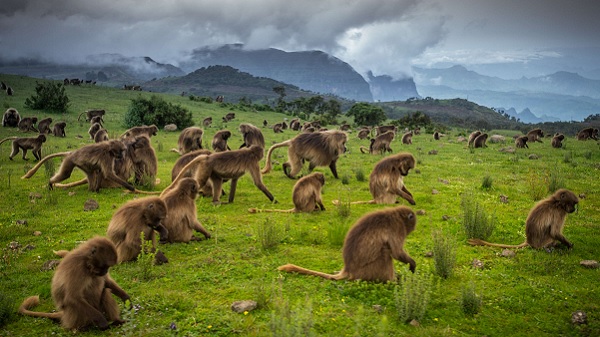
Human activity continues to pose the most significant threat to the Simien Mountains National Park and its wildlife. Today, 582 households, representing more than 3,000 individuals, are located within the park.
By Hannah Wilber (AWF) |
With a plethora of endemic species of birds, mammals and plants, there’s no other place on Earth quite like Ethiopia’s Simien Mountains National Park. The protected area encompasses more than 400 sq. km of mountains in the northern part of the country, including Ras Dejen, one of the highest peaks in all of Africa. It’s also the East African nation’s only natural World Heritage Site.
The national park was established in 1969, primarily to protect the landscape’s unique wildlife. This includes the walia ibex, a wild mountain goat with large, scimitar-like horns; the gelada monkey (sometimes called the “bleeding heart baboon”), the world’s last species of grass-eating primates; and the Ethiopian wolf, our planet’s rarest canid. More than 200 species of birds and 250 species of plants are also found inside the park.
The Simien Mountains National Park offer more than just critical habitat for rare wildlife, however. They’re also an important watershed for the region, with several year-round rivers originating inside park boundaries. These rivers are an essential source of water for communities downstream in Ethiopia, Sudan and Egypt.
Simien Mountains National Park: a national park under threat
Despite its ecological significance, threats to the health of this ecosystem and its inhabitants abound. Pressures arising from growing human activity, combined with the impacts of civil war during the late 1980s, led to dramatic habitat degradation and sharp declines in both Ethiopian wolf and walia ibex populations. As a result, the UN Educational, Scientific and Cultural Organization (or UNESCO) moved the park to its List of World Heritage Sites in Danger in 1996, where it has remained ever since.
Human activity continues to pose the most significant threat to the park and its wildlife. Today, 582 households, representing more than 3,000 individuals, are located within the park. Another 1,477 households are found around its perimeter. These locals have two main options for supporting their families: agriculture and livestock. But, as communities expand their cultivation and seek out grazing areas for their livestock, the park suffers. Grazing inside the park in particular has gone largely unregulated and unmanaged. This is now the leading cause of soil erosion and habitat degradation within park boundaries.
Enter EWCA: Ethiopia’s wildlife authority
Encouragingly, however, the proverbial tide is turning for this unmatched landscape. In 2007, the Ethiopian Wildlife Conservation Authority (EWCA) was established under the country’s Ministry of Culture and Tourism. The authority is responsible for overseeing 10 national parks within Ethiopia, including Simien Mountains.
Like many wildlife authorities across Africa, EWCA’s capacity has been limited by a shortage of resources, meaning scout patrols for wildlife protection have been irregular and enforcing park regulations has proven difficult. That’s where AWF comes in.
Read the complete story at African Wildlife Foundation
——
See also:
- EWCA Calls for United Effort against Wildlife Trafficking
- Rare Ethiopian Wolves Begin to Recover from Recent Tough Years
- Ethiopia: Up in the Mountains with an Impressive Array of Wildlife
- Authority Expanding, Reestablishing Simien Mountains Nat’l Park
- Having the Best out of Both: Holiday Season and Ethiopia’s Delightful Adventures
